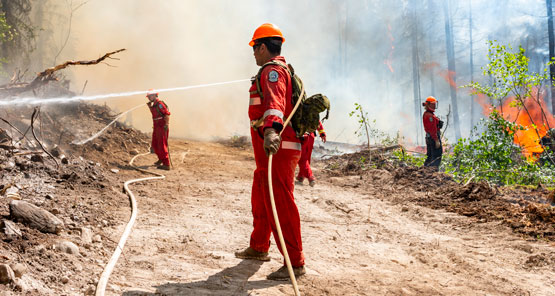October 26, 2023
Wildland fires, pandemics, floods, and more – Canada is increasingly feeling the consequences of extreme disasters. Defence Research and Development Canada (DRDC) is committed to finding ways to prepare for and mitigate the devastating effects of these catastrophes. By collaborating with Public Safety Canada (PS) to develop and test the All-Hazards Risk Assessment (AHRA) methodology, DRDC’s Centre for Security Science (CSS) primed Canada’s first approach for determining and addressing the challenges that lie ahead.

Canadian Armed Forces members from 1 Combat Engineer Regiment and 39 Canadian Brigade Group spray water onto a recent burn area, helping British Columbia Wildfire Services suppress fires near Burns Lake, British Columbia, on 04 Aug. 2023. Photo: Corporal Alexandre Brisson, Visual Communications Support, Canadian Armed Forces Photo
The five steps of the All-Hazards Risk Assessment:
- Setting the Context: What are the target organization’s goals and limitations?
- Risk Identification: What are the potential short-term and long-term risks?
- Risk Analysis: How likely are the risks to occur, and what would their impacts be?
- Risk Evaluation: Are the risks manageable?
- Risk Treatment: How can the risks be addressed?
The AHRA is a framework developed to help different departments within the Government of Canada determine and execute their role in assessing risks – work that leads to better ideas on how to address them.
DRDC’s CSS took the initial application of the framework and kicked it up a notch, moving from government departments to Canada as a whole. Their work on adapting the methodology to a much larger, more complex scale meant the risk-assessment framework could be applied at a national level.
This work on the AHRA helped set the stage for the development of Canada’s Public Safety-led National Risk Profile (NRP). PS used the adapted AHRA model, focusing on risk identification and analysis, and integrated it with a capability-based planning approach to understanding system resilience. This is a first-of-its-kind initiative in Canada that gives Canadians the information they need to prepare for and recover from disasters, examining the likelihood and consequences of Canada’s costliest hazards: wildland fires, earthquakes, and floods.
“DRDC’s original work on developing the framework and methodology for the federal all hazards risk assessment laid the foundation and way ahead for Canada’s implementation of the NRP,” says a DRDC spokesperson. “Our partnership with Public Safety Canada has resulted in an initiative that will keep Canada prepared in the years to come.”
Related links:
- Defence Research and Development Canada
- Government of Canada releases first national-level disaster risk assessment
- Backgrounder: What is the National Risk Profile? (publicsafety.gc.ca)
- National Risk Profile (publicsafety.gc.ca)
- National Risk Profile Methodology (publicsafety.gc.ca)
- Backgrounder: Future of the National Risk Profile (publicsafety.gc.ca)
